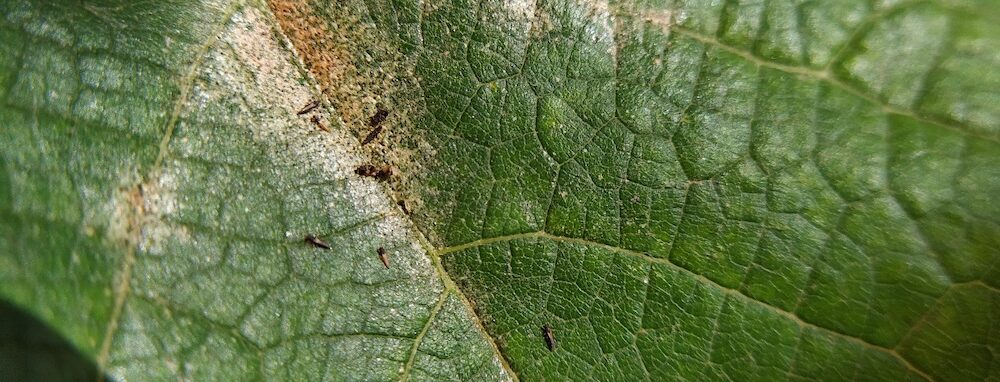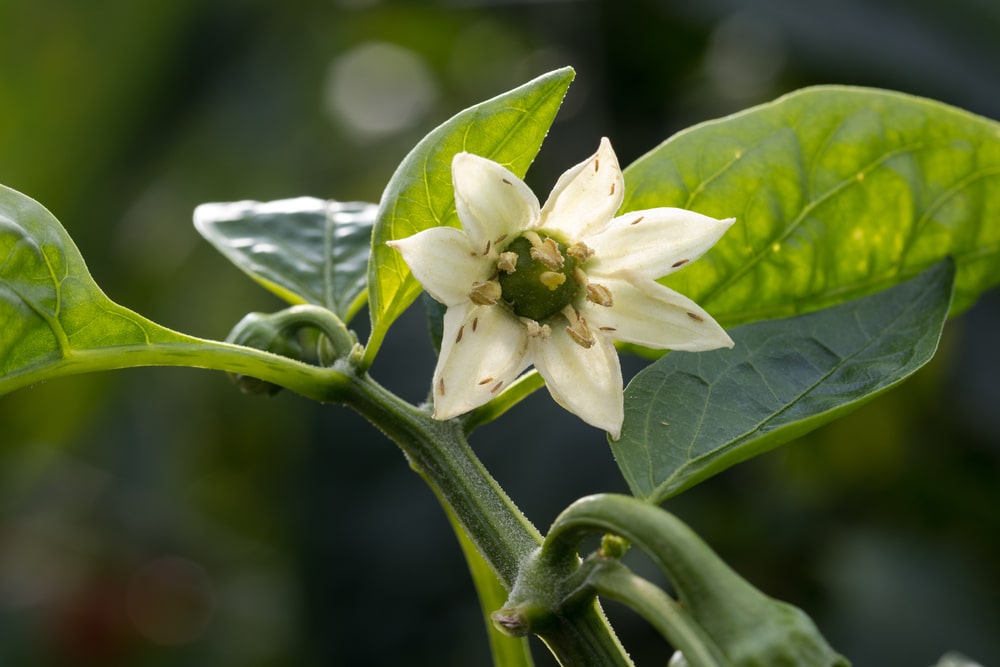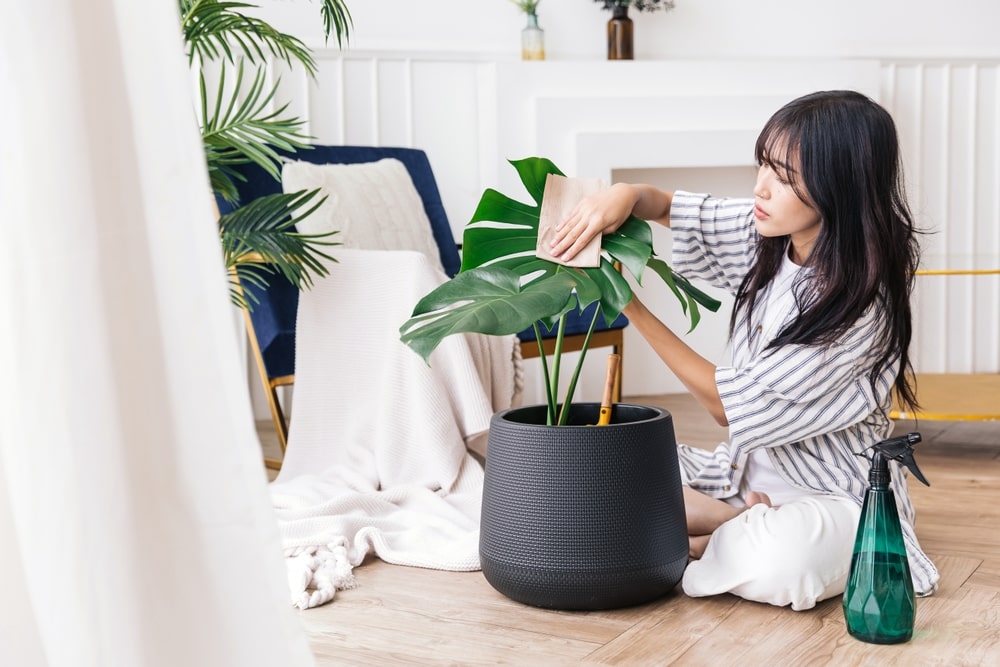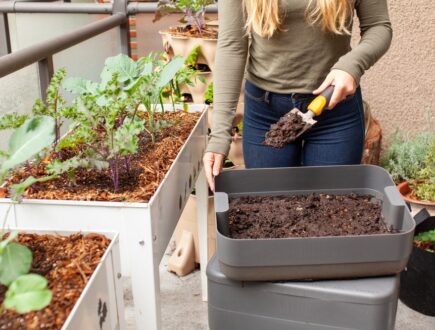Log in or create new account to save this product to your wishlist.

How to Prevent & Treat Thrips on Your Plants
Thrips are tiny insects that can spread quickly, damaging your plants. Find out how to identify an infection and what to do to eradicate the pests for good.
🌱 All important maintenance moments for your lawn during the year. Leave your email and we will send you the lawn calendar for free.
Enter your email
Receive the lawn calendar in the mail
Enjoy a green lawn all year round!

- Order by 2PM = shipped today
- 250.000+ satisfied customers!
- 60 day satisfaction guarantee
Have you seen tiny silvery-white spots on your plant’s leaves? Are your plants growing more and more slowly? Perhaps you’ve spotted little black balls sitting around the plant? It sounds like thrips could be responsible!
- What are thrips?
- What do thrips and their larvae look like?
- The life cycle of thrips
- Damage caused by thrips
- Which plants are affected by thrips damage?
- Recognising a thrips infection
- Fighting thrips infection
- Plant care after infestation
- FAQs
Thrips are tiny insects that roam around your garden but can also get indoors, affecting your house plants.
In this article, you’ll learn how to spot thrips and what to do when you identify an infection.
Let’s get started!
What are thrips?

Thrips are also known as thunder flies, storm flies, thunder bugs, corn flies, harvest bugs, or by their Latin name, Thysanoptera.
These tiny fringe-winged insects belong to the Thysanoptera family, of which there are around 5500 species worldwide. Measuring as little as 0.5mm in length (up to 14mm), their dark brown bodies can be challenging to spot.
Their diminutive size and the fact that they reproduce asexually make it difficult to spot an early infection, which is problematic because thunder flies spread quickly. They’ve even been known to get inside household objects, such as furniture or computer monitors, where they sit between the front glass and the LCD screen.
The name “thrips” originates in Ancient Greek, meaning “woodworm”, and refers to both the singular and plural. So, it’s not “one thrip, two thrips”; it’s “one thrips, two thrips”.
What do thrips and their larvae look like?

The adult insects are yellow at the head end and dark brown at the hind end. Their distinctive cigar-shaped bodies accommodate six “bladder-like” legs and four feathery, fringed wings with compound eyes and asymmetrical mouthparts.
Their eggs are almost invisible to the naked eye, laid into plant tissue, but the tiny, sausage-shaped larvae (around 1mm long) are colourless or white until they mature after feeding into the second instar stage, where they turn yellow.
Thrips tend to appear completely static until you look closer, where you’ll spot tiny movements.
While thunder flies have wings, they’re not great flyers. They can fly weakly and have developed a “clap and fling” approach to flight, where they create lift by using an unsteady wing pattern. Nonetheless, their feather-like wings aren’t suitable for conventional flight.
The life cycle of thrips
Female adult thunder flies lay up to 70 eggs on leaves or plant stems during their lifetime. They can reproduce either sexually or asexually.
Amazingly, the plant on which the eggs are laid influences the speed at which they hatch. For example, on Chrysanthemum, they hatch after just three days if the temperatures are between 18-36℃, but other plants vary their gestation period.
The egg hatches into the first instar larvae before developing into the second instar larvae after three days of eating. This second stage lasts for around ten days, depending on the ambient temperature, until the larvae are fully grown. At this stage, it pupates — usually in the soil — lasting for around a week, when it emerges as the adult thrips.
Adult thrips live for around 45 days.
Damage caused by thrips
Thunder flies use their mouthparts to drill holes into leaf surfaces, allowing them to suck sap from the plant’s cells. This turns the leaf yellow with prominent vines.
Later, the leaves turn brown, and in the case of severe infection, the entire plant shows significant growth disorders or stunted shoots.
Which plants are affected by thrips damage?

Thrips infect a wide variety of indoor and outdoor plants, including:
- Orchids
- Cyclamen
- Club lilies
- Chrysanthemums
- Monsteras
Additionally, they can hit vegetable crops quite severely, particularly:
- Cucumbers
- Peppers
- Tomatoes
- Aubergines
Recognising a thrips infection
One of the main problems with thunder fly infections is that they’re difficult to spot early. And we all know that if we catch a condition early, it’s easier to treat.
Typical signs of infection are:
- Silvery-white spots on the leaves
- Growth retardation
- Small black balls on the leaves of stems
- Stunted shoot growth
Fighting thrips infection
Act as soon as you identify the infection. Here’s how to fight them:
Rinse the infested plant
Place the infested plant in the shower or bathtub and rinse the foliage thoroughly with insecticidal soap. Repeat this process regularly to eliminate the pests.
Use beneficial insects
You can buy packets of Amblyseius cucumeris (a.k.a. thrips killer mites), which are predatory mites that eat thunder flies.
You can buy these online or in garden centres, and they are effective in the fight against thrips. Once the infestation has gone, the mites die off.
Neem oil for thrips infestations
Neem oil is a natural insecticide that’s effective against thrips. Simply dab infested plants with the oil to kill the pests.
Fly papers for killing thunder flies
This isn’t recommended as a stand-alone approach to catching and killing thrips, but hanging fly papers around the home and garden can help attract the tiny critters. Remember, they’re not great flyers, so this approach will only catch the insects in flight.
Replace the soil
Once the eggs have hatched into their larval form, they often drop off the leaves and land in the soil substrate. So, replacing the top layer of soil or compost can help interrupt the reproductive cycle of thunder fly infections.
Use olive oil detergent

A mix of olive oil, washing up liquid and water can be effective against thrips. Spray the plants regularly with this mix; the thrips will struggle to cling to leaves.
Cut off the younger leaves
In case of severe infection, removing a plant’s young leaves may be necessary, as the thrips often use these to hide.
Plant care after infestation
After eliminating the insects, your plants will need some extra TLC.
Check all foliage for any signs of reinfection, and remove the insects manually if you spot a fresh outbreak. Use a magnifying glass to help spot these sometimes microscopic insects.
Remove any remaining thrips by wiping the leaves with a damp cloth and a little insecticidal soap.
Then, keep the plants well watered, placing them in a sunny spot (if they’re sun-lovers) and feeding them with an appropriate fertiliser.
Keep monitoring the plant for signs of reinfection.
FAQs
Thrips can be challenging to spot, so the problem can quickly get out of hand. Wipe the plant’s foliage with a damp cloth impregnated with insecticidal soap to combat thrips. Or spray neem oil over the foliage, which kills the bugs. Check the plant regularly for signs of recurrence.
Thrips are often found in greenhouses or around house plants, attracted by the warmth. Always check new plants for signs of infection before introducing them because it spreads quickly. The larvae often develop in the soil, so remove the top layer of compost if you think there’s a risk of infection.
Thrips tend to live in the foliage of various outdoor and indoor plants. The adult female lays eggs on stems or leaves, which can drop off into the soil when hatching into larvae. So, while they don’t live exclusively in the ground, they can develop into adults in the earth.
Any questions?
I hope this article has helped you identify and tackle those troublesome thrips, but if you have any questions, drop us an email.
Or explore our comprehensive Help & Advice section for everything garden and lawn care related!
Thanks for reading.
-
How to Grow Eucalyptus in British GardensWith a little love and care, eucalyptus trees can thrive in English gardens. Since they don’t germinate well without proper help, there are not considered invasive. So, there is no reason not to plant them if you enjoy their looks.Read more
-
Transform Your Garden with All-Year-Round Flowering PlantsDid you know you can enjoy blooming flowers even in January? With the right selection of all year round plants, there’s no need to wait until spring to add some colour to your garden.Read more
-
How to Create a Butterfly Garden: A Simple Guide for British GardensThe UK's butterfly population includes 59 different species. These beautiful winged creatures face a steady decline because of habitat loss, pollution and changing weather patterns. Your garden can become a vital link between nature reserves and natural habitats. Let’s explore how.Read more
-
Volcanic Rock Dust for Your Garden—Application and TipsDid you know that volcanic rock dust is a brilliant organic soil improver? This article explains exactly what it's good for and how to use it properly.Read more
-
How to Use Landscape Fabric ProperlyIf weeds or erosion in your garden are troubling you, landscape fabric might be the solution. We’ll explain how and when to use it properly, just keep on reading.Read more
-
Hostas: A Complete Care GuideIf you have a north-facing garden or some shady corners on your property, hostas are the plants for you. These green delights thrive particularly well in partial to full shade and require consistently moist soil to perform at their best.Read more
-
How to Grow Grapes in Your Garden: A Simple Step-by-Step GuideGrapevines produce some tasty fruits, but often they are simply grown for their gorgeous leaves. Whatever your motivation may be, we have a guide on how to grow grapes for you.Read more
-
Worm Composting Made Simple: From Kitchen Scraps to Garden GoldDid you know that a single pound of composting worms can devour half their body weight in waste every day? That's roughly twelve pounds of kitchen scraps transformed into garden gold each month! We will look at how to make this happen.Read more
Leave a comment
Your answer will be displayed on the site and the interested party will be notified by email.
Leave a comment
Have a question or want to share your experience? Leave us a comment.

- Order by 2PM = shipped today
- 250.000+ satisfied customers!
- 60 day satisfaction guarantee

- Order by 2PM = shipped today
- 250.000+ satisfied customers!
- 60 day satisfaction guarantee

- Order by 2PM = shipped today
- 250.000+ satisfied customers!
- 60 day satisfaction guarantee

🌱 All important maintenance moments for your lawn during the year. Leave your email and we will send you the lawn calendar for free.
Enter your email
Receive the lawn calendar in the mail
Enjoy a green lawn all year round!
















 Summer Deal! Get 15% off the
Summer Deal! Get 15% off the 




Comments (0)
There are no comments yet. Well then, what are you waiting for to
Be the first to write your comment!inaugurate this pretty page?
Do you have some comments?